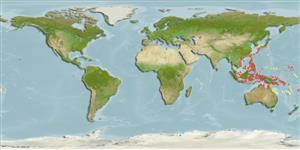>
Gobiiformes (Gobies) >
Gobiidae (Gobies) > Gobiinae
Etymology: Cryptocentrus: Greek, kryptos = hidden + Greek, kentron = sting (Ref. 45335).
Environment: milieu / climate zone / depth range / distribution range
Ecologia
marino associati a barriera corallina; distribuzione batimetrica 1 - 5 m (Ref. 90102). Subtropical
Western Pacific: Philippines, Taiwan, the Ryukyu Islands, and Palau.
Size / Peso / Age
Maturity: Lm ? range ? - ? cm
Max length : 7.5 cm SL maschio/sesso non determinato; (Ref. 48637)
Short description
Chiavi di identificazione | Morfologia | Morfometria
Spine dorsali (totale) : 6 - 7; Raggi dorsali molli (totale) : 11; Spine anali: 1; Raggi anali molli: 10. Resembles C. leucostictus and C. maudae, but lacks dark bars dorsally.
Characterized by the following: brilliant white snout and back; brown color on most of head and body with variable-sized white spots; white spot on base of upper pectoral fin rays; basal part of lower pectoral fin with white spot or triangular marking; united pelvic fins, presence of frenum; longitudinal scale series 113-130; head without scales; greatest depth of body 5.9-6.3 in SL; rounded caudal fin, slightly longer than head (Ref. 90102).
Lives in silty sandy substrate with small boulders or large rubble pieces in few meters depth (Ref. 48637). Associated with snapping shrimp in their burrows.
Life cycle and mating behavior
Maturities | Riproduzione | Spawnings | Egg(s) | Fecundities | Larve
Masuda, H., K. Amaoka, C. Araga, T. Uyeno and T. Yoshino, 1984. The fishes of the Japanese Archipelago. Vol. 1. Tokai University Press, Tokyo, Japan. 437 p. (text). (Ref. 559)
IUCN Red List Status (Ref. 130435)
Threat to humans
Harmless
Human uses
Strumenti
Special reports
Download XML
Fonti Internet
Estimates based on models
Preferred temperature (Ref.
123201): 25.2 - 29.3, mean 28.8 °C (based on 1604 cells).
Phylogenetic diversity index (Ref.
82804): PD
50 = 0.5000 [Uniqueness, from 0.5 = low to 2.0 = high].
Bayesian length-weight: a=0.00708 (0.00333 - 0.01504), b=3.09 (2.92 - 3.26), in cm total length, based on LWR estimates for this (Sub)family-body shape (Ref.
93245).
Trophic level (Ref.
69278): 3.3 ±0.4 se; based on size and trophs of closest relatives
Resilienza (Ref.
120179): Alto, tempo minimo di raddoppiamento della popolazione meno di 15 mesi (Preliminary K or Fecundity.).
Fishing Vulnerability (Ref.
59153): Low vulnerability (10 of 100).
